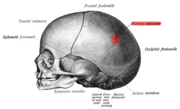The parietal eminence (parietal tuber, parietal tuberosity) is a convex, smooth eminence on the external surface of the parietal bone of the skull. It is the site where intramembranous ossification of the parietal bone begins during embryological development. It tends to be slightly more prominent in men than in women, so may be used to help to identify the sex of a skull.[1]
| Parietal eminence | |
|---|---|
 Skull of a new-born child from the side. (Parietal eminence shown in red.) | |
 Front view of the skull. (Parietal eminence pointed by arrows.) | |
| Details | |
| Precursor | Site of intramembranous ossification of the parietal bone |
| Part of | Parietal bone |
| System | Skeletal |
| Identifiers | |
| Latin | tuber parietale, eminentia parietalis |
| TA98 | A02.1.02.010 |
| TA2 | 510 |
| FMA | 57080 |
| Anatomical terms of bone | |
Additional images
edit-
Parietal eminence shown in red
-
Skull showing parietal eminence as Tuber parietale
References
editThis article incorporates text in the public domain from page 133 of the 20th edition of Gray's Anatomy (1918)
- ^ Rogers, Tracy L. (May 2005). "Determining the sex of human remains through cranial morphology". Journal of Forensic Sciences. 50 (3): 493–500. doi:10.1520/JFS2003385. ISSN 0022-1198. PMID 15932077 – via PubMed.
External links
editWikimedia Commons has media related to Parietal eminence.
- "Anatomy diagram: 34256.000-2". Roche Lexicon - illustrated navigator. Elsevier. Archived from the original on 2013-06-11.